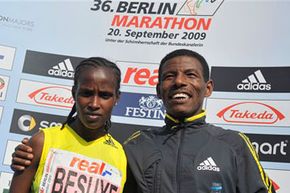If you're a veteran marathoner looking to set a personal best -- or a newbie seeking a flat, fast course for your first marathon -- the Berlin Marathon could be the race for you. It's the third-largest marathon in the world (after New York and London) -- and the fastest. With its level route through central Berlin, it has a reputation for producing stellar times and being extremely well-organized. Many experienced runners call it their favorite event in the world, and in 2009, it was named the Marathon of the Decade by the Association of International Marathons and Distance Races. And just in case you need a little more incentive, you'll get a spectacular sightseeing tour of the historic city as you run (or skate or walk) the course.
The real Berlin Marathon is organized by SCC-Running, one of Berlin's largest sports clubs, and sponsored by real-hypermarkets (Germany's answer to Wal-Mart). In the inaugural event in 1974, spearheaded by a group of SC Charlottenburg runners, 286 participants raced through the Grunewald forest near Berlin. Humble beginnings, yes, but only three years later it produced its first world record when Christa Vahlensieck finished in 2:34:47. The marathon remained on the Grunewald course until it moved into the city in 1981 -- but the race was confined to West Berlin throughout the 1980s. In 1990, three days before Germany's reunification, 25,000 marathoners ran through Brandenburg Gate and into East Berlin for the first time.
Advertisement
The Berlin Marathon, held on the last weekend of September every year, has grown to include almost 40,000 runners -- it's now one of the World Marathon Majors, along with New York, Boston, Chicago and London. If you feel like taking a trip to Germany and running 26.2 miles while you're at it, we'll show you how on the next few pages.


